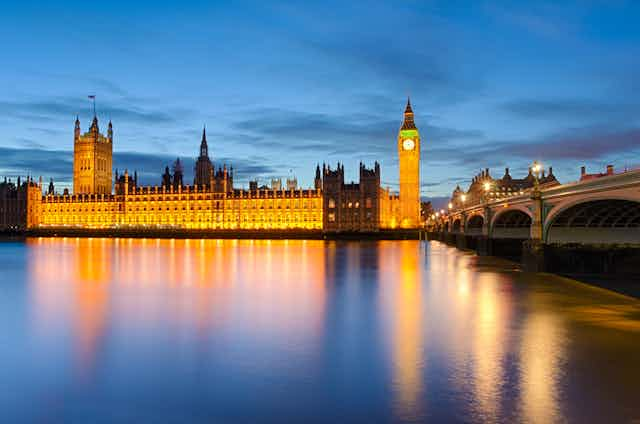The UK’s House of Commons has been the scene of many memorable confrontations over the years – especially during the weekly theatrics of Prime Minister’s Questions (PMQs). Things got particularly nasty when prime minister David Cameron lashed out at Jeremy Corbyn this month, saying “[my mother] would look across the despatch box and say, ‘put on a proper suit, do up your tie and sing the national anthem’”.
It’s easy to accuse MPs of childish behaviour. But efforts to rise above these conflicts are hampered by the confrontational design of Westminster itself.
The debating chamber is configured to play out rivalries, rather than encourage collaboration: the “opposition” is addressed “across the despatch box”, and “crossing the floor” is seen as the ultimate act of betrayal. Which leaves us with the uncomfortable question: is the Palace of Westminster bad for politics?
Building consensus
Language, ritual, institutions and the built environment all help to define our culture. So it’s no surprise that the shape of a parliament sets the tone for its proceedings. The majority of historical legislatures worldwide have debating chambers that are circular or semicircular. Indeed, all new assembly buildings constructed in the EU over the past 15 years have deployed this form – also known as a “hemicycle” – to promote productive debate and consensus.
A good example can be found in the European Parliament in Strasbourg, inaugurated in 1999. The main debating chamber is a hemicycle, while the building itself takes a cylindrical form, signifying unity.

Another exemplar of democratic design is the Reichstag – home of the German parliament – which opened in 1992. As well as being a symbol of rebirth following German unification, the building expresses the significance of democratic processes through its form and layout.
The new glass dome at roof level allows views over Berlin, and into the debating chamber below, literally shedding light on the process of democracy. A ramp circles the dome, allowing members of the public to move above the heads of the politicians below, symbolising the subservience of elected representatives to their people.

And it’s not just Europe which recognises the importance of architectural design for democracy – other government buildings in the UK have also embraced the guiding principles of openness and transparency. The National Assembly for Wales, designed by award-winning architect Richard Rogers, is described as a building which “perfectly reflects the modern forward-thinking democracy and approach to politics that are developing in Wales.”
What’s more, the debating chamber of the Scottish parliament is a hemicycle, with plenty of glazing to allow light in and guarantee good views. The chamber is directly accessible from the main entrance, which fronts a public plaza and a landscaped park, ensuring that the parliament is physically closer to the public realm.
Even London’s own City Hall – the glassy headquarters of the Greater London Authority, designed by Foster and Partners and opened in 2002 – has at its heart a debating chamber, which is circled by an internal ramp and stair that connects all floors. The chamber is open to the public and visible from the Riverwalk and the plaza outside, which makes the building transparent and accessible – just as we’d like its proceedings to be.

Aside from government, other decision-making bodies such as company boards usually make a point of discussing their strategies around a table. Similarly, many legal disputes are resolved prior to court by mediation, involving the views of both sides, the experts and other interested parties around a table with the collective aim of finding resolution.
Moving on
We’ve long known that the Palace of Westminster – a UNESCO world heritage site – is in urgent need of renovation and modernisation. An independent report was published last year, proposing five options for repair and renewal, and another is expected this year which will recommend a preferred option. Construction is anticipated to commence in the early 2020s, and is likely to take between 30 to 40 years. The costs are estimated to be between £4bn and £7bn.
But all this rather begs the question – why wasn’t a new building considered to be the home of British democracy? This could have been an opportunity to create a new chamber – one that isn’t encased in dark timber panelling, remote from public space, with no natural light or view of the outside and a layout that promotes separation and confrontation.
The UK could learn from the examples on show around the world to create a government building with strong links to the public realm; a building that is light, accessible and sustainable and, most importantly, has a chamber that facilitates positive, inclusive, collegiate debate. There’s no doubt that the Palace of Westminster is a building of huge historical significance – but it’s hardly symbolic of a forward-thinking democracy.

